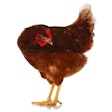
Highly pathogenic avian influenza outbreaks continued into June 2022 with commercial, wild bird and backyard cases.
In a WATT Poultry Chat interview, Dr. Thomas Elam, president of FarmEcon LLC, said the next hope is the summer heat will stop the spread of the disease.
Austin Alonzo: We have to talk about avian influenza again, we thought it would be over in May and it's continuing. What's the present situation?
Thomas Elam: Well, we had, of course, huge numbers of birds that were sacrificed in April and May. And now we've had in June, two more outbreaks in commercial facilities. But it's been about 10 days since we had the last one and hopefully, these will be the last two.
Apparently this is a much more communicable variety and much more widespread than the 2015 episode was. We've had outbreaks in all the major wild bird flyways, from east coast to west. In 2015, it was pretty well isolated to the Upper Midwest and Mississippi flyway. But we've had outbreaks in almost I think about 40 states now. If you count non poultry species, wild birds that have been found and very small operations, zoos and petting zoos. It's been a very, very widespread outbreak. And we're continuing to see some backyard flocks, even up until this week that have been discovered. So it's not over yet for commercial flocks.
But the good news is we had a couple of fairly good sized flocks in, I think it was around the first week of June that showed up as positive. In fact, I sent you a chart on that you can see it very clearly. That chart is total birds, for layers, turkeys and broilers with no breeding stock. Luckily, the breeding stock numbers have been pretty small. So it's been mainly the commercial meat type and egg type ins and in birds that have been sacrificed to eliminate this disease at least controlling it. Hopefully, this is the last of it.
I sent you another chart that has it broken out by species. And, as was the case in 2015, it's been mainly, if you look at just birds, it's been predominantly laying hens and there's a good reason for that. Because the laying hen flocks are much larger than any of the other flocks in a house or on a premise. You can have up to 3 million laying hens on one premises, as is the case with the facility here in Indiana. There aren't any small ones left. They're all big commercial operations, half a million up to millions of birds on a site. When it breaks out on the site, always birds have got to go. So when we look at bird numbers, by far and away, it's been hens, laying hens. But we've also had a significant number of turkeys. Unlike the 2015 outbreak, a significant number of commercial broiler flocks that have had to be sacrificed.
So again, hopefully this warmer weather, extremely hot weather we've had across the country, dry and hot in the last couple of weeks, will be the end of this.
Like I said the only place where we haven't had the we haven't seen the end of this is probably on the west coast the small backyard flocks.
Again, as if, corn and inflation and higher interest rates weren't enough, we add this on top of it. I think, in fact, in total the economic impact of this 2022 outbreak is going to be more than the last one. Let's hope this is the end of it here in June.
This transcript edited for length and clarity.



















